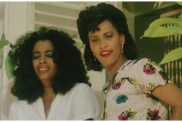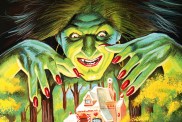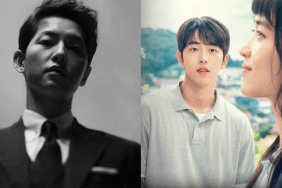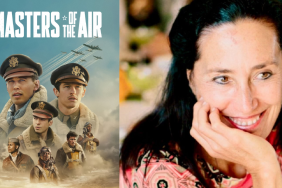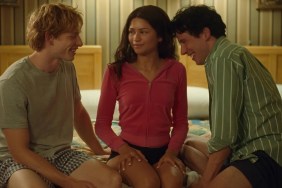Director of the Horrorfest III original film
After Dark Films breaks new ground in its 2009 edition of the “8 Films to Die For” Horrorfest. Rather than enter its third year (running January 9th – 15th) with more acquisitions, After Dark head Courtney Solomon and his team filtered two original horror film productions into the mix. Perkins’ 14 was one (a joint venture with Massify.com), the other was Stewart Hopewell’s Slaughter.
An art and film major hailing from Virginia, Hopewell makes his feature directing debut with the latter, a calculatedly bipolar experience (so says its director). With the holidays upon us and the 9th closing in, ShockTillYouDrop.com got a chance to connect with Hopewell to learn more about his film – he was optimistic, confident and well in tune with knowing when to hold back from spilling the beans…like any seasoned director. Still, he offered enough to whet our appetite for Slaughter.

ShockTillYouDrop.com: Was Slaughter a spec that landed in the hands of After Dark Films or was it something you pitched to them?
Stewart Hopewell: It’s one of those purely random Hollywood stories. At the time, I had been in L.A. for about four years and had written a couple of scripts, including Slaughter which was about two years ago. I had started pitching it around to agents on a very small scale to get some feedback. The feedback was great, but it wasn’t the right time to get it made. It went into the realm of available material. A friend of mine, Aimee Barth, was a producer at another company and decided to take the project under her wing. She took it around town and gave it to Eryl Cochran who was working at Odd Lot at the time. She liked it, but it wasn’t right for Odd Lot. [Later], in the middle of the night, I got an e-mail from Eryl asking if the script was still available. She was now working at After Dark. She remembered it, liked it and thought it was perfect for Horrorfest. Aimee and her started talking and in January I came in and the ball got rolling from there.
Shock: And it had a different title at the time, didn’t it? I remember it was announced under another name.
Hopewell: It was originally called Slaughter and the reason we changed the title to Faithless was because director Victor Garcia had a picture called Slaughter. It was in development at the time and I didn’t want to have any confusion between the two. After Dark liked the title Faithless at the time, but as the project came to fruition and we got to the final cut we decided Slaughter was the better title. And I guess the Victor Garcia project is on hold.
Shock: Alright, well, here’s the tough question – what’s Slaughter about? I haven’t seen it yet.
Hopewell: I’ll do my best here. [laughs] Basically, what it is is a story about two girls, Faith and Lola, who meet at the bar and become really fast friends because they have a lot in common. Faith winds up moving to Lola’s family farm. The reason she’s done this is because she has an abusive ex-boyfriend who she’s hiding from. Something happens and she decides it’s best to just chill at Lola’s. They develop this friendship. And while Faith is there, she starts to meet Lola’s family. In a word, they’re a bit “creepy.” Lola’s mom passed away and she’s left with her dad and two brothers who are a bit off. As Faith is taking it all in, she realizes they might be a bit more than creepy, they might be abusive. She’s coming from this past and comes to care about Lola. One night, she sits Lola down and talks her into getting out and starting fresh. Lola’s happy about that and they decide to run off, but before they can bad stuff goes down.

Shock: Unless you’re drawing from personal experience and you were attacked by a random family, where did this story come from for you?
Hopewell: No, I tried not to get attacked. I came up with the story with a friend Tim Long, from Florida, and we were throwing around ideas, trying to draw a thriller on the concept “how well do you know your roommate and your roommate’s family?” We just took it from there and it evolved. It is inspired by a true story from 100 years ago. It’s a modern-day interpretation of it. There are a few twists and turns in the movie, I’m a bit hesitant to mention what the true story is in fear of blowing it. It is a cool, wild story though. Anyways, we had this concept, then this true story and they both melded well together. What ended up happening is the movie is a movie with two parts. The first half of it is a deliberately-paced, suspenseful thriller. There is a lot of character development and you’re learning what’s going on with these people. Then when the girls decide to leave the farm, that’s when it really takes off. Tonally, it’s a bit of a shift. Most horror movies, somebody gets killed by page one but ours is a little different.
Shock: A lot of great films have that slow burn build-up to a big release. Straw Dogs, for instance, something I just caught again on DVD…
Hopewell: Straw Dogs is a great example and that’s something we embraced for this. I don’t know how well we’ve achieved the ’70s feel, but we were shooting for that grainy feel.
Shock: Were you allowed to shoot on film, or did you go digital?
Hopewell: It was a hard fight, but we got to shoot on super-16 and posted it all in 1080. We’re doing a blow-out on 35mm. I’m super happy, it adds to the quality of the film.
Shock: Your two leads, Lucy Holt and Amy Shiels, hail from the UK, is that because you shot in Romania?
Hopewell: Exactly. We spent about a month casting and auditioning a ton of girls in L.A. and then we discovered that we did need to cast in the UK. I was a little wary because the movie is set in the south, in and around Atlanta, Georgia. After Dark said we were going to shoot in Romania and we’re going to use UK actors. [laughs] That was going to be tough. But Holt and Shiels just floored me. They’ve got the accents.

Shock: How did they hold up against the rigors you put them through at the end of the film?
Hopewell: Shiels, this girl can crank out some tears on command and was really able to amp up the energy. In terms of just acting talent, she’s really good. Started out as a child actor. Lucy Holt was absolutely amazing. She’s a bit different, though. Used to be a model. She didn’t really have a ton of film experience, but you wouldn’t know it. Her character, Lola, is complicated and she just wowed everybody. We were going between a couple of actors and then Lucy came in and we were just so surprised by what she did and what she had to do for the audition. She also changed our minds on how we perceived the character.
Shock: Did you ever expect to get thrown to Romania for your feature debut? How did that work out for you?
Hopewell: It was a trip. The funny thing about it, is we did pick-ups for this movie in August and we used an American crew and we were in Atlanta and I was so freaked out to be with a crew that spoke English. We shot just north of Bucharest and had a great crew. The language barrier was there sometimes, but a lot of them spoke English. There are a lot of producers on this film, but two, Matthew Kuipers and Chris Millburn, they did Courtney Solomon’s American Haunting in Romania with kind of the same group of people, which is part of the reason we went there. Their relationship with the Romanians is really strong. In such a short period of time, it was tough to look around and find a location that was remotely like Atlanta. The architecture is definitely different. Even the ways they park the cars on the street. They’ll pull up on sidewalk and I had to keep telling the production designer that the cars should be parallel on the road.

All of the water tanks at Media Pro, where we shot the film, were booked and so we had to come up with an outside the box way to shoot the underwater scenes. They had this junkyard area with a large aquarium about six feet tall and ten feet wide or whatever. My production designer, my director of photography and I were just looking at it and we thought we could just turn off the lights and put the camera on one side. Shoot through the glass. We decided to use that for our underwater stuff. People didn’t think it could work out but it actually worked okay. It restricted our ability to shoot from a couple of angles but it was more than we could hope for.
Shock: Why set the story in Atlanta?
Hopewell: I went to school in Tallahassee, Florida and Atlanta was a town I went to a lot. I had friends there. I’m a fan and we just pictured it as a cool southern city to set it in. A lot of, when writing the film, we were exploring the idea of this girl Lola who’s such a cool character. She’s this farm girl and lives in the country, but she likes going into the city. And when she goes to these swank bars and clubs, she looks like this cosmopolitan chick.
Shock: Does Slaughter live up to its title?
Hopewell: It definitely has its share of gore. I would say the first part of the film is like Hitchcock, the second half is like Hostel. It’s not torture porn, but there are some pieces that are pulled and arms that are taken away from their bodies. There is a body count. All the way through to the last scene of the movie, the body count is much higher than you expected it to cut. We don’t pull any punches. I was very worried about getting an NC-17 rating.
To learn where Slaughter will be playing near you, visit HorrorfestOnline.com.





Source: Ryan Rotten, Managing Editor
